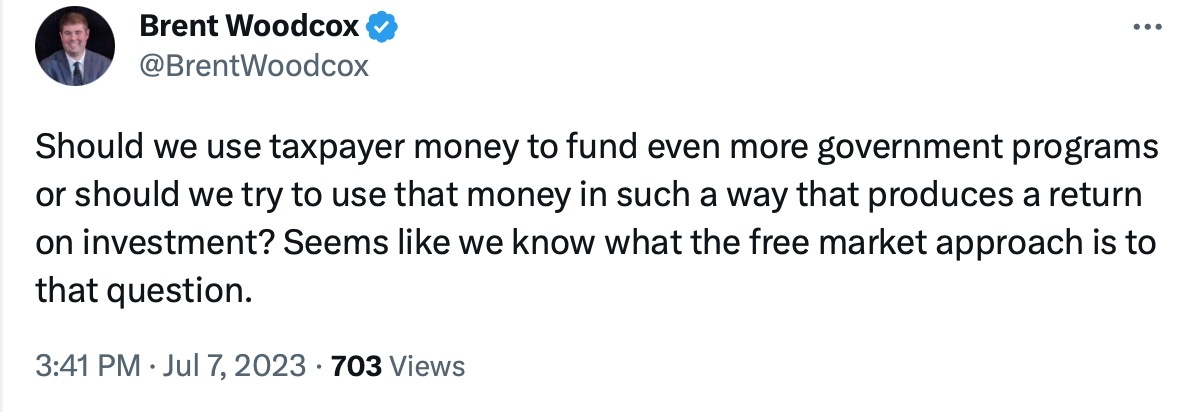- An influential staffer at the General Assembly recently described NCInnovation as a “free market approach”
- The description relies on a gross mischaracterization of free markets
- As a government program using taxpayer dollars doled out by political appointees, there is nothing “free market” about NCInnovation
The North Carolina Senate’s decision to include $1.4 billion for NCInnovation in their budget proposal has stirred up quite the controversy. The program would use taxpayer dollars to help facilitate more technological research and development at University of North Carolina campuses and also provide funding for startup companies seeking to bring such technology to market.
The Locke Foundation has panned this proposal for being both an obvious crony operation diverting taxpayer dollars to certain companies hand-picked by political appointees as well as lacking even the most basic of transparency requirements and separation of powers in its oversight.
The main justification for the proposal by NCInnovation backers is that North Carolina “lag(s) the national average” in commercializing university research, so therefore more government “investment” is needed to solve this supposed problem.
The excuse-making for NCInnovation reached laughable levels recently, however, when longtime legislative attorney for Senate leader Phil Berger (R-Rockingham), Brent Woodcox, took to Twitter to insist that the program represents a “free market approach” to improving our state’s economy.

There are several problems with Woodcox’s declaration, but for the sake of brevity I’ll concentrate on three.
False choice
For starters, Woodcox presents a false choice involving just two options: “fund even more government programs” or use the tax dollars to produce a “return on investment.” First off, NCInnnovation is another government program. It’s organized by the government, funded by the government, granted special privileges by the government, and directed by political appointees.
Moreover, those aren’t the only two options for how $1.4 billion in taxpayer dollars can be used. It could be returned to taxpayers or used to leverage an even more rapid decrease in our income tax rates. It could be set aside in the Savings Reserve Fund to bolster that already robust reserve and better protect state finances against the looming recession. Or it could be dedicated to curtailing the nearly $40 billion in unfunded pension and health care liabilities or paying down the nearly $4 billion in tax-supported General Fund state debt, either of which would ease taxpayer burdens for years to come.
Woodcox acts as if the only two possible options are the ones he presents, disingenuously tipping the scales in favor of his preferred option.
Missing what the “free” in free market means
That Woodcox can with a straight face declare that NCInnovation presents a “free market approach” is evidence that a brief primer on free markets is in order.
By “market,” we refer to buyers and sellers engaging in transactions with each other, along with the various actions and interactions that create the vast patterns of production and exchange we call “the economy.”
By “free,” we mean free from government intervention, aside from enforcement of property rights and contractual agreements. As such, “free market” consists of people voluntarily using their own money and property to engage in buying, selling, producing, and investing. The decision makers are the people.
Clearly, NCInnovation violates these basic free market principles. The funding comes from the collection of taxes, decidedly not a voluntary transaction. From there, the political appointees award other people’s money to their chosen businesses, shielding the decision makers from any personal risk or reward from these so-called investments. The people whose money is at stake — the taxpayers — have no say over how their money is allotted.
Political “return on investment”
Finally, Woodcox tries to adapt the market concept of “return on investment” to NCInnovation. But NCInnovation is a political, not market, entity. As such, whatever “return on investment” being referenced is political in nature, not the market-based financial returns most people are familiar with.
Politicians are self-interested actors motivated by acquiring, expanding, and holding on to political power. As such, political “returns on investment” involve the improvement of these political aims.
Politicians shore up their power through multiple means, including rewarding their donors, creating greater dependency that makes for a reliable voting bloc, and financing patronage networks to create greater loyalty.
NCInnovations’ “investments” should be expected to be focused on these goals, rather than the careful fiduciary oversight of taxpayer dollars. Creating a massive, $1.4 billion endowment featuring political appointees doling out funds to hand-picked companies will no doubt create the perfect recipe for corruption and cronyism.
Conclusion
Nothing about the Senate’s NCInnovation proposal resembles a free market. Advocates of actual free markets should diligently refute any attempts to distort or mischaracterize what the free market represents, such as what defenders of NCInnovation are attempting to do. Favorable opinions of free markets are disappointingly low among Americans, especially the younger generation.
Labeling crony government programs like NCInnovation as free market will only further erode that favorability, diminishing support for the greatest engine of poverty reduction the world has ever known.


